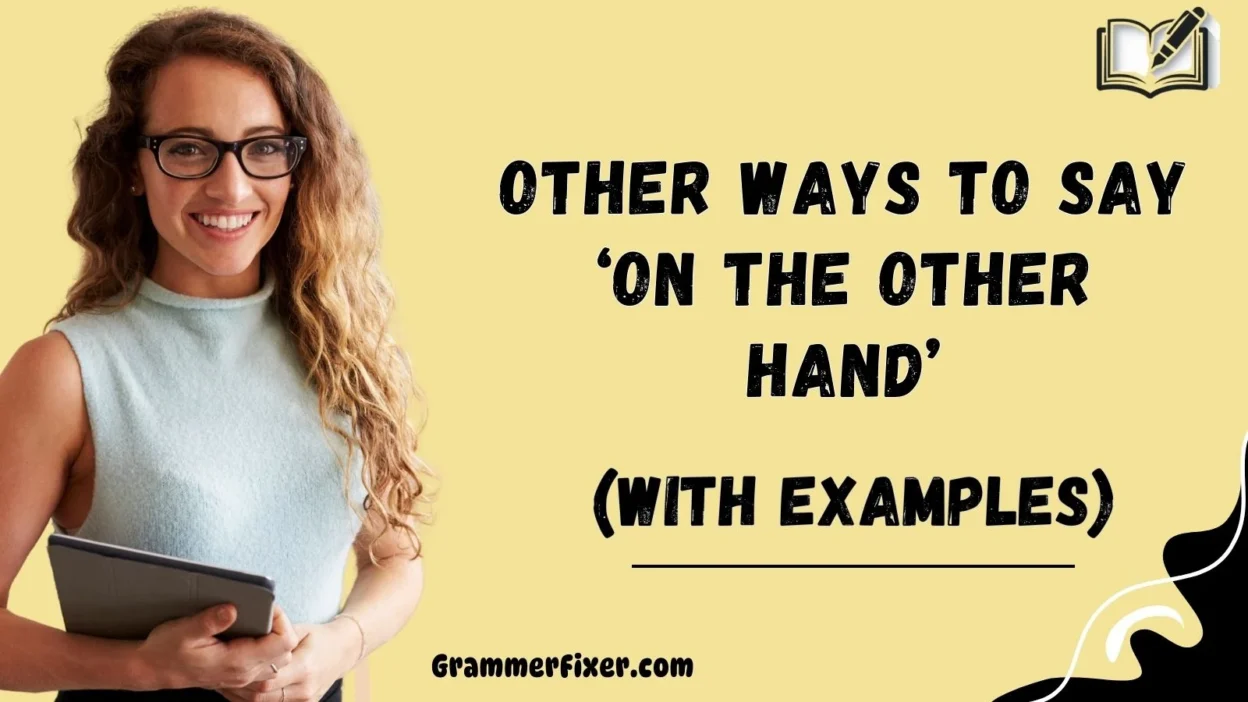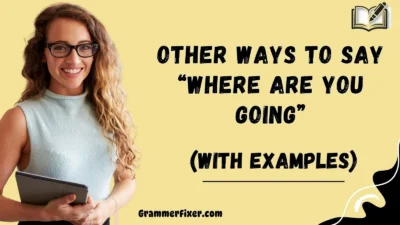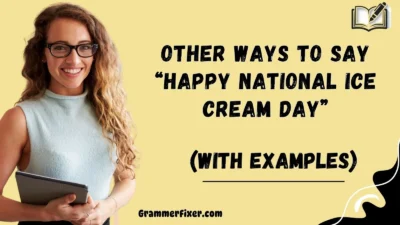Finding the right words can make all the difference in how we connect with others. When navigating discussions, debates, or everyday conversations, we often need to express contrasting ideas without sounding repetitive or overly formal.
That’s where alternatives to “On The Other Hand” come in. These expressions can help you balance perspectives, acknowledge differing viewpoints, and communicate with warmth, care, and thoughtfulness.
Below, you’ll find 30 engaging alternatives—complete with their meanings, explanations, examples, best use, and tone—to enrich your communication.
What Does “On The Other Hand” Mean?
“On the other hand” is a conjunctive phrase used to introduce a contrasting idea, argument, or perspective. It helps to show balance, comparison, or consideration of an alternative viewpoint.
When to Use “On The Other Hand”?
You use “on the other hand” when you want to:
- Present two sides of a discussion.
- Introduce a counterpoint in writing or speaking.
- Show a balanced perspective in professional or casual communication.
- Weigh pros and cons of a situation.
Is It Professional/Polite to Say “On The Other Hand”?
Yes, it is both professional and polite. It works well in formal writing (essays, reports, emails) and in casual conversation. However, relying on it too often can make your language feel repetitive or predictable.
Pros or Cons
Pros:
- Easy to understand.
- Universally recognized.
- Effective in both speech and writing.
Cons:
- Can feel overused.
- Sometimes lacks nuance compared to other options.
- May sound a bit mechanical if repeated in close proximity.
1. However
Meaning: Introduces a contrast or opposing point.
Explanation: Often used at the start of a sentence to show a shift in thought.
Scenario Example:
“I enjoy working from home. However, I sometimes miss the team atmosphere in the office.”
Best Use: Academic writing, professional reports.
Worst Use: Overuse in casual chat—it can sound stiff.
Tone: Neutral, polished.
2. Although
Meaning: Introduces a contrasting clause within the same sentence.
Explanation: Shows contradiction but keeps both ideas connected.
Scenario Example:
“Although the product is expensive, it delivers excellent quality.”
Best Use: Essays, reflective writing.
Worst Use: Starting every thought—it reduces clarity.
Tone: Formal but accessible.
3. Yet
Meaning: Signals something surprising or contrasting.
Explanation: Highlights unexpected differences between two ideas.
Scenario Example:
“The restaurant is small, yet the food is world-class.”
Best Use: Casual writing, speeches.
Worst Use: Long formal reports.
Tone: Conversational, impactful.
4. Nevertheless
Meaning: Expresses contrast while acknowledging validity.
Explanation: Suggests that despite the previous statement, the following point still stands.
Scenario Example:
“It was raining heavily; nevertheless, the event continued smoothly.”
Best Use: Professional discussions, reports.
Worst Use: Informal texts—it feels too heavy.
Tone: Formal, respectful.
5. Nonetheless
Meaning: Similar to “nevertheless” but slightly more casual.
Explanation: Highlights contrast without dismissing the earlier statement.
Scenario Example:
“She was tired; nonetheless, she finished the project on time.”
Best Use: Emails, semi-formal writing.
Worst Use: Strict academic papers—better to use “nevertheless.”
Tone: Balanced, softer.
6. Conversely
Meaning: Expresses the direct opposite of a statement.
Explanation: Often used in formal or academic writing.
Scenario Example:
“Remote work increases flexibility. Conversely, it may reduce collaboration.”
Best Use: Research, debates, professional articles.
Worst Use: Text messages or casual chats.
Tone: Scholarly, precise.
7. Alternatively
Meaning: Suggests another option or possibility.
Explanation: Useful when presenting a different choice rather than a contradiction.
Scenario Example:
“You could take the train. Alternatively, a car ride might be quicker.”
Best Use: Offering options in business or personal settings.
Worst Use: Harsh debates where opposition is stronger.
Tone: Practical, neutral.
8. Whereas
Meaning: Highlights contrast between two ideas.
Explanation: Commonly used in comparisons.
Scenario Example:
“Whereas John prefers early mornings, Sarah enjoys working late at night.”
Best Use: Contracts, formal writing, analytical comparisons.
Worst Use: Quick texts—it feels too formal.
Tone: Objective, structured.
9. In Contrast
Meaning: Directly emphasizes differences.
Explanation: Strongly signals comparison.
Scenario Example:
“His presentation was detailed. In contrast, mine was brief and focused.”
Best Use: Reports, essays, presentations.
Worst Use: Repeated in casual talk—it feels rigid.
Tone: Analytical, professional.
10. On the Flip Side
Meaning: A more casual, conversational alternative.
Explanation: Expresses a lighter version of contrast.
Scenario Example:
“I like living in the city. On the flip side, it can get noisy.”
Best Use: Friendly conversations, blogs.
Worst Use: Academic writing.
Tone: Relaxed, informal.
11. Still
Meaning: Shows that something remains true despite the previous point.
Explanation: Adds weight to an idea by contrasting it with what came before.
Scenario Example:
“The movie had poor reviews. Still, it managed to attract large crowds.”
Best Use: Informal speech, conversational writing.
Worst Use: Overused in formal academic essays.
Tone: Simple, casual, flexible.
12. On the Contrary
Meaning: Introduces a statement that directly opposes a previous one.
Explanation: Stronger than “on the other hand,” often used to correct or oppose.
Scenario Example:
“Some think the project was a failure. On the contrary, it exceeded expectations.”
Best Use: Professional debates, persuasive writing.
Worst Use: Friendly chats—it can sound defensive.
Tone: Assertive, direct.
13. Rather
Meaning: Suggests preference for one idea over another.
Explanation: Useful for soft contrasts and redirection.
Scenario Example:
“She didn’t ignore him. Rather, she was too busy to respond right away.”
Best Use: Polite corrections, academic writing.
Worst Use: Angry debates—it can feel dismissive.
Tone: Polished, diplomatic.
14. Instead
Meaning: Expresses an alternative action or choice.
Explanation: A straightforward word to show replacement of one idea with another.
Scenario Example:
“Let’s not go out tonight. Let’s cook dinner at home instead.”
Best Use: Everyday speech, casual and professional writing.
Worst Use: Highly formal reports—it can feel too simple.
Tone: Practical, neutral.
15. All the Same
Meaning: A softer way to express contrast.
Explanation: Acknowledges the previous point but emphasizes another valid perspective.
Scenario Example:
“It was a tiring day. All the same, it was very rewarding.”
Best Use: Friendly conversations, reflective writing.
Worst Use: Business presentations—it may sound too casual.
Tone: Gentle, thoughtful.
16. While
Meaning: Expresses two ideas happening simultaneously but in contrast.
Explanation: Highlights differences in one smooth sentence.
Scenario Example:
“While the product is affordable, it lacks durability.”
Best Use: Academic essays, comparative writing.
Worst Use: Standalone contrast—it works better within sentences.
Tone: Balanced, formal.
17. Contrary to This
Meaning: Highlights opposition or contradiction.
Explanation: Best for showing direct contrast with a previous statement.
Scenario Example:
“Many expected the company to struggle. Contrary to this, it performed better than competitors.”
Best Use: Business reports, articles.
Worst Use: Informal chats—it feels too heavy.
Tone: Serious, formal.
18. By Comparison
Meaning: Directly measures one thing against another.
Explanation: Emphasizes similarities or differences clearly.
Scenario Example:
“Her essay was detailed. By comparison, mine was much shorter.”
Best Use: Analytical writing, presentations.
Worst Use: Texts—it sounds academic.
Tone: Objective, explanatory.
19. In Another Light
Meaning: Suggests looking at the same idea from a new perspective.
Explanation: Encourages reconsideration of an idea.
Scenario Example:
“Her strictness seemed harsh. In another light, it showed her dedication.”
Best Use: Reflective writing, coaching, motivational talks.
Worst Use: Cold debates—it may seem vague.
Tone: Warm, thoughtful.
20. That Said
Meaning: Softens a shift in perspective while maintaining balance.
Explanation: Bridges ideas in a conversational way.
Scenario Example:
“I love working remotely. That said, I sometimes miss office teamwork.”
Best Use: Casual writing, emails, blog posts.
Worst Use: Academic reports—it feels informal.
Tone: Friendly, approachable.
21. Even So
Meaning: Indicates something remains true despite a counterpoint.
Explanation: Similar to “nevertheless” but more casual.
Scenario Example:
“The exam was tough. Even so, many students passed with high scores.”
Best Use: Conversational writing, essays.
Worst Use: Repeatedly in business writing—it weakens impact.
Tone: Balanced, reassuring.
22. In Opposition
Meaning: Expresses an idea that directly resists another.
Explanation: A strong way to highlight disagreement.
Scenario Example:
“The manager supported the new policy. In opposition, some employees raised concerns.”
Best Use: Debates, academic papers.
Worst Use: Friendly discussions—it feels confrontational.
Tone: Assertive, formal.
23. Differently
Meaning: Introduces a distinct perspective or approach.
Explanation: Useful when presenting unique ideas.
Scenario Example:
“Most people saw the problem as technical. She viewed it differently, as a communication issue.”
Best Use: Coaching, reflective writing.
Worst Use: Harsh rebuttals—it may sound dismissive.
Tone: Neutral, flexible.
24. Be That As It May
Meaning: Acknowledges the previous statement but pushes another point forward.
Explanation: Keeps the conversation balanced yet forward-moving.
Scenario Example:
“It’s true he has little experience. Be that as it may, he’s highly motivated.”
Best Use: Formal writing, persuasive communication.
Worst Use: Informal chats—it feels outdated.
Tone: Formal, authoritative.
25. On Balance
Meaning: Weighs pros and cons before presenting a conclusion.
Explanation: Suggests a final judgment after consideration.
Scenario Example:
“On balance, the benefits of the new policy outweigh the risks.”
Best Use: Decision-making, reports, essays.
Worst Use: Small talk.
Tone: Reflective, analytical.
26. From Another Angle
Meaning: Introduces a new way of looking at a situation.
Explanation: Encourages flexible thinking and broader perspectives.
Scenario Example:
“From another angle, the delay might actually help us prepare better.”
Best Use: Coaching, leadership talks, brainstorming.
Worst Use: Academic reports—it can sound vague.
Tone: Creative, open-minded.
27. Inversely
Meaning: Shows an opposite relationship.
Explanation: Technical or mathematical but also useful in structured writing.
Scenario Example:
“Productivity rose; inversely, costs dropped.”
Best Use: Academic or technical writing.
Worst Use: Casual chats.
Tone: Precise, formal.
28. Flipping the Perspective
Meaning: Encourages re-examining a situation from the opposite side.
Explanation: More casual and visual in tone.
Scenario Example:
“Flipping the perspective, setbacks can be seen as learning opportunities.”
Best Use: Blogs, personal development, team talks.
Worst Use: Formal essays.
Tone: Creative, conversational.
29. In a Different Vein
Meaning: Indicates a shift in direction while staying related.
Explanation: Moves the discussion to a different but connected point.
Scenario Example:
“We’ve discussed risks. In a different vein, let’s explore the opportunities.”
Best Use: Speeches, reflective writing.
Worst Use: Harsh debates—it feels too gentle.
Tone: Warm, nuanced.
30. Another Way of Seeing It
Meaning: Simplifies the idea of perspective-taking.
Explanation: Encourages open discussion by acknowledging multiple viewpoints.
Scenario Example:
“It may look like a failure. Another way of seeing it is as a valuable lesson.”
Best Use: Coaching, everyday conversations.
Worst Use: Very formal documents—it feels too relaxed.
Tone: Empathetic, encouraging.
Conclusion
“On the other hand” is a reliable phrase, but having 30 alternatives gives you the freedom to adapt your tone, audience, and context. Whether you’re writing an academic essay, presenting in a meeting, or simply having a heartfelt conversation, choosing the right phrase can soften your message, highlight balance, and connect with people more meaningfully.
By experimenting with these expressions, you’ll enrich your communication, avoid redundancy, and make your ideas feel more considered and engaging. Remember, the right words aren’t just about grammar—they’re about showing empathy, thoughtfulness, and care in how you connect with others.



